Referral marketing could be your company's golden ticket.
Well-executed referral marketing strategies can spark business development, raise brand recognition, create leads, and boost corporate revenues.
This article is your ultimate guide to everything you need to know about harnessing this power.
So let’s get going!
Done properly, referral marketing (sometimes known as 'word-of-mouth marketing') sees you gain new buyers by relying on the recommendations of existing satisfied customers.
Giving your current customers incentives to promote your brand's products or services is the heart of an effective referral marketing process.
While face-to-face talks and client testimonials remain important components of new business creation, major client dialogues now happen online because of how vital the internet is.
More than five billion people were using the internet as of April 2022; that’s more than 63% of the planet's population.
Out of this total, 4.7 billion people (59% of the global population) used social media.
That’s why businesses care about digitizing quality referral marketing programs and consumer incentives.
Casper, a novelty mattress business, launched an excellent referral marketing strategy.
They created a name for themselves by providing low-cost delivery of foldable and compact mattresses; when you open the package, the product grows to its full size.
Regarding the business’s referral marketing campaign, the company has provided a dual-sided referral reward to attract clients; giving the referrer a $100 Amazon gift card and the referee a 20% reduction on their first order.

Image Source: Casper
Now the brand is making the reward extra sweet for a limited time!
They’re offering the referrer a $200 Amazon gift card instead of the standard $100 gift card when one friend buys a mattress; the referee also gets 15% off any purchase.
Overall, this type of valuable incentive promotes business value, encourages word of mouth, and enhances the connection between all customers.
Using referral tactics is one of the best methods to increase your customer base and generate new leads for your company.
Engaging new clients is much more costly than maintaining existing ones.
However, one of the advantages of referral marketing is that this cost has less overall impact because people who participate in a referral process are more likely to stay loyal.
According to statistics, referred clients have an 18% lower turnover rate than others.
Referral marketing helps clients understand the narrative behind your business, which can improve your overall reputation and boost your presence.
Therefore, allowing current customers to inform their friends and potential customers about your company adds authenticity to your brand.
So, your referred customers will add to your storytelling and help you achieve your goals, boosting your business’s growth overall. According to Heinz marketing, 86% of organizations with robust referral programs enjoy revenue increases.
Customers are loyal to businesses that make them feel valued, and companies that don’t pay them much attention lose out to competitors who do.
By delivering a more tailored contact and making them feel valued, referral marketing programs help you to keep tabs on your most dedicated customers and subscribers, and reward them for their trust and support.
CAC has climbed by 60% in the last few years.
Companies that depended on paid advertisements to acquire new consumers reported a drop in new customers and a rise in expenses.
To illustrate, paid advertising may help in brand recognition yet a straightforward referral program reduces CAC costs—a constant concern for both large companies and retailers and small businesses or startups—and increases return on investment, enabling organizations to advance more quickly.
This can be explained by a simple mechanism: satisfied consumers attract new ones, and these new clients often don't cost much.
Hence, through referral marketing, businesses can acquire new customers in a way that’s easier and more cost-effective.
Furthermore, the customer lifetime value (CLV) grows higher when a new client arrives through a suggestion or advocacy.
Now that we have checked all of these great benefits, let’s see together six referral marketing tactics that will transform your marketing efforts.
There are many referral marketing strategies you can try for your business.
Let’s check them in detail below and inspire your next moves.
A double-sided incentive program rewards both the referrer and the referee, and Airbnb decided to implement and optimize this strategy.
The brand sought to create a database of global visitors willing to rent flats, rooms, and residences worldwide.
So, to encourage people to travel, the home-sharing business gave their existing customers travel credits: $25 when a friend they referred rented from Airbnb and $75 when a friend they referred put their property up for rent on the site.
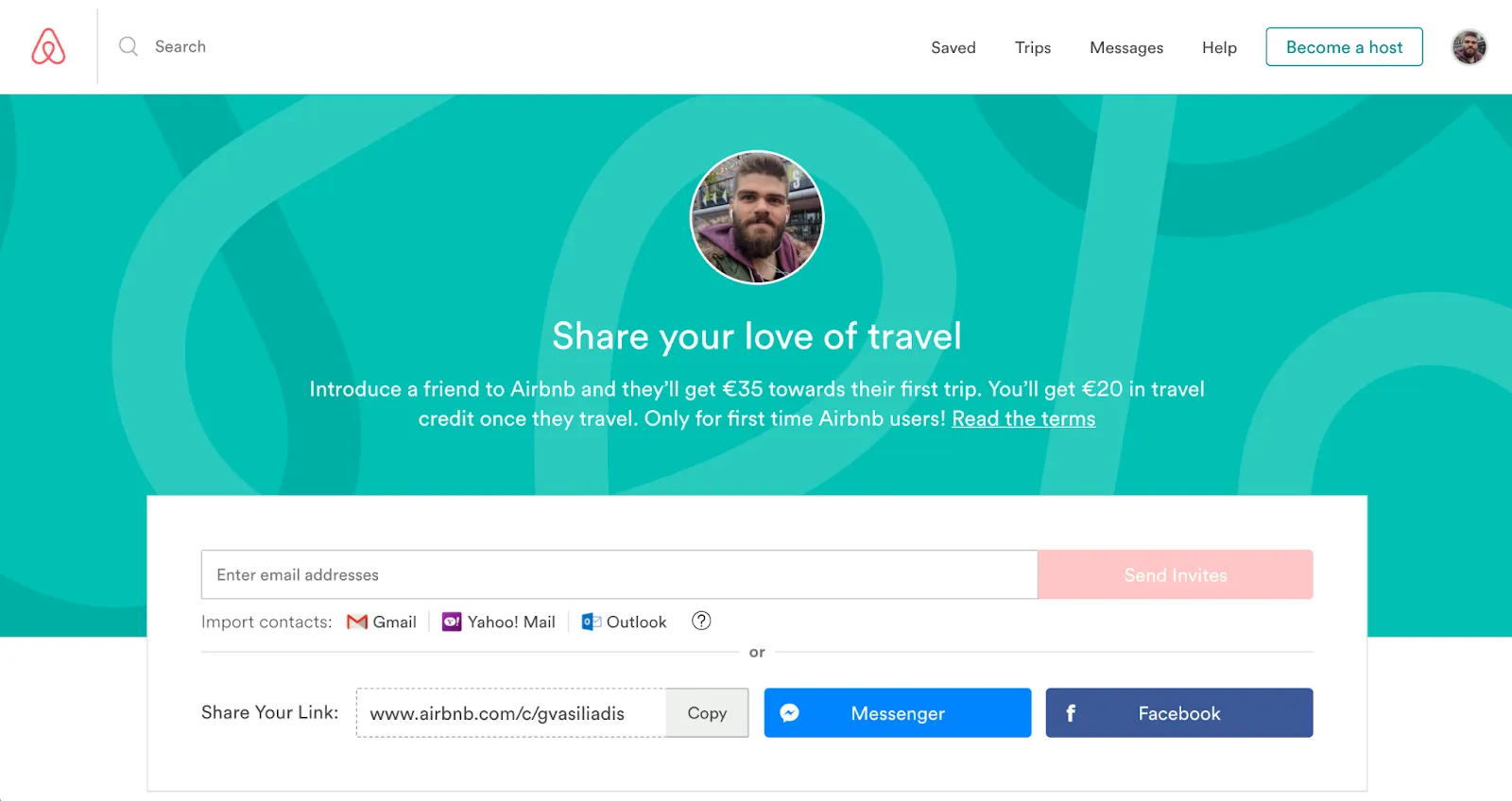
This referral marketing strategy has benefited Airbnb because it turned away people who just wanted to collect free products and didn’t care about what the business is or stands for.
In addition, the referral reward brought in people who want to travel, which is the main target audience for the company.
When PayPal first began, they handed money free to new and referred users.
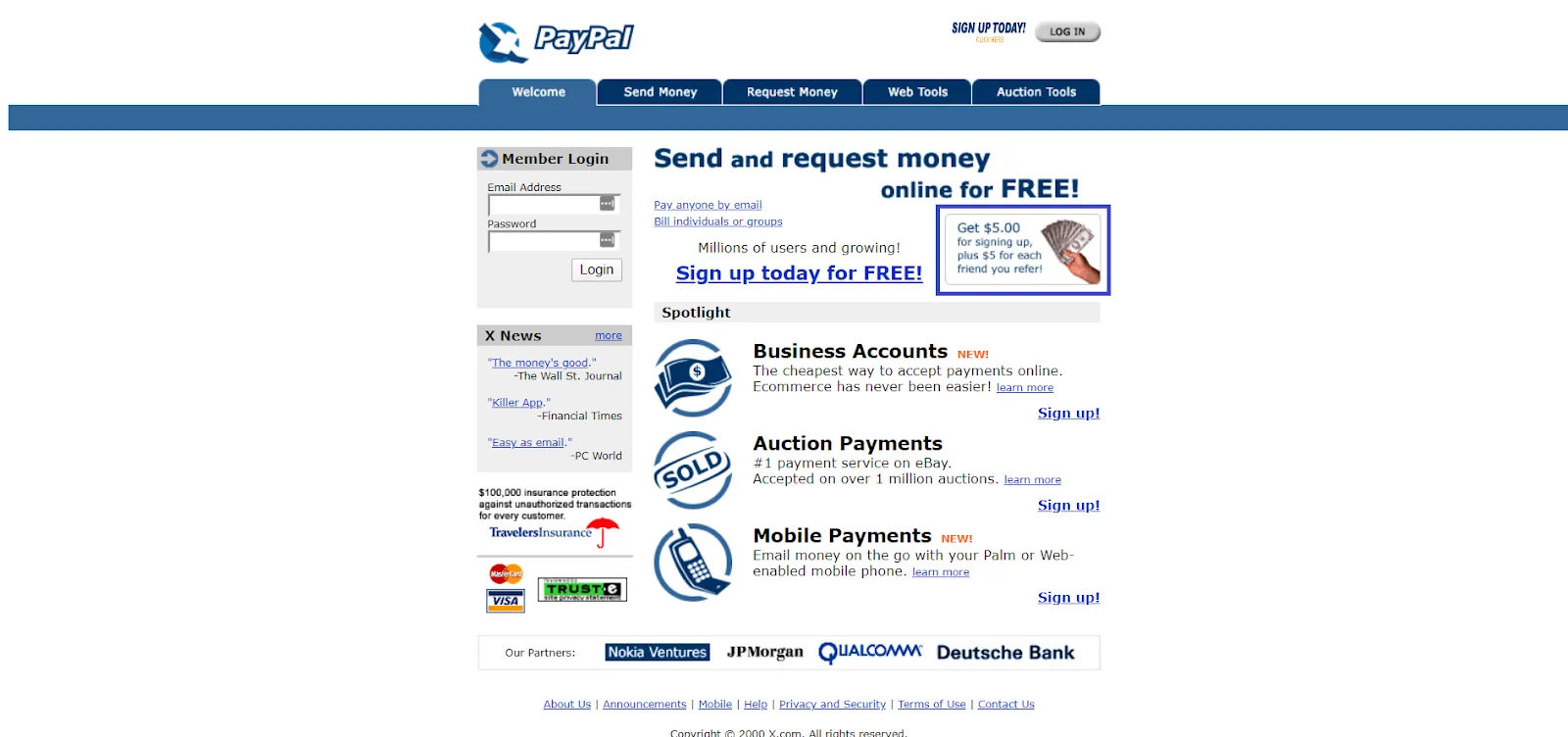
It worked so effectively that they had to cut the amount of money they handed out.
Initially, PayPal granted their new users $20 just for signing up, plus $20 for everybody their existing customers recommended; they then reduced it to $10.
The incentive remained incredibly popular, although the ecommerce brand reduced the price to $5 afterward.
Moreover, PayPal's daily growth rate was between 7 and 10%, and the user base eventually topped 100 million.
Their referral incentive was based on free cash, which made things go super viral as no one would ever reject such a reward, making the process a win-win situation!
When a person clicks on a referral link, they are sent to a referral landing page (which can take the form of an email, a social media post, or a website menu link) and they are clearly interested in learning more about your program and incentives.
Landing pages let you go into greater detail about your referral program's rules, benefits for users, and other crucial details.
So, it’s vital to create a specific and distinctive landing page for your referral program since this is where visitors will be checking every detail.
The page should aim to persuade visitors to sign up for your referral program and become brand advocates or referrers.
The good news is that you can always check different templates and see what suits you best.
Give our referral templates a shot, for example, and see how they can work for your business.
Social media has altered the marketing environment by making it more straightforward for consumers and companies to interact.
Celebrity endorsements gave rise to influencer marketing and sponsored content, which are excellent methods for new businesses to connect with and engage their customers.
Overall, influencer marketing increases brand recognition by ensuring product exposure and allowing brands to target particular demographics.
However, marketing goes beyond that.
To illustrate, influencer marketing complements word-of-mouth and referral marketing successfully.
People who follow influencers have family members and friends who share their preferences and interests; so you can reach the followers and their contacts network.
So, businesses can tailor their content marketing to individual consumers to enhance sales.
This is significant because the more people identify with a brand, the more inclined they are to purchase anything.
In general, once you've collaborated with influencers, they're the ideal complement to referral programs since consumers trust recommendations from people they know more than they trust recommendations from businesses.
According to Twitter, almost 40% of the platform’s users say they've purchased something as a direct outcome of an influencer's tweet.
This insight demonstrates the importance of including influencer marketing in your referral program and marketing channels.
By doing so :
For these reasons, consider how much reach you can get by including influencer marketing in the mix.
You can take many approaches to influencer marketing in your referral program; what matters is that you collaborate with the correct influencers and make an offer relevant to your target audience.
Robinhood is a free stock trading app; it gives all users access to all financial markets.
When a user refers a friend to the app, the user and the referee get a free share of stock.
What’s more, these equities can come from big companies like Facebook and Apple.
Furthermore, Robinhood does an excellent job of providing value to its customers and making sharing as simple as possible.
Here's how:
Robinhood begins this process with a push notification that provides just enough information to entice consumers to click.
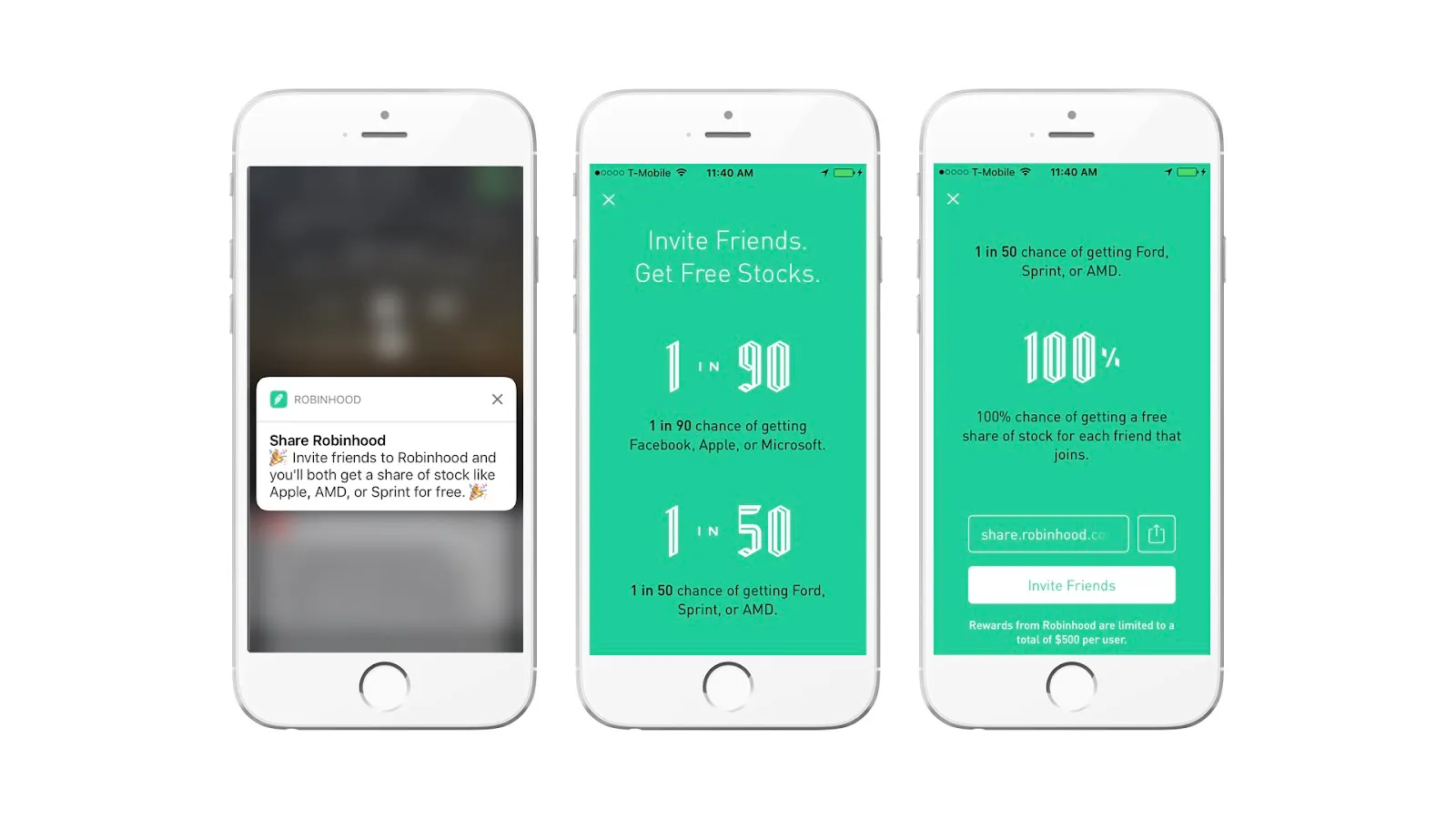
When the consumer clicks on the push notification pop-up, they’re sent to an educational message flow that provides an honest perspective on the offer while still building enthusiasm.
Also, the design is clear and simple to understand and navigate which is a great bonus.
Then, in the in-app message, it’s disclosed that users who bring friends have a 1 in 90 chance of receiving a free share of stock from companies such as Facebook, Microsoft, or Apple.
Quite a smart customer experience and an exciting type of referral!
Chatbots can discuss the referral program benefits that brand supporters can receive.
Bots, unlike referral email marketing and website advertisements, keep things simple.
In addition, their conversational character allows them to market in a non-intrusive manner.
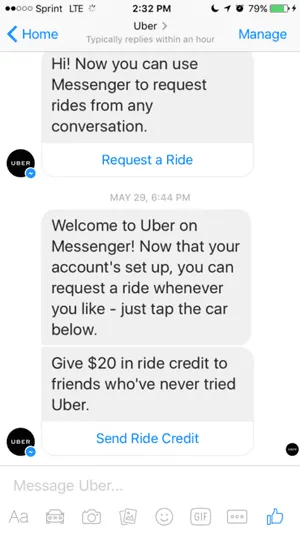
For instance, Uber's chatbot informs clients that they can order a trip.
It gives referees $20 ride credits while referrers can just recommend their friends with the press of a button; this low-key marketing readily attracts people's attention.
These companies have mastered the art of recognizing their target demographic.
In addition, they have created tailored referral programs that streamline user experiences.
Uber employed a $10 dual-sided referral reward (paid in Uber credits) to recruit new passengers and encourage current riders to share with their friends.
Later, they increased the stakes by offering $20 and $30 dual-sided credit incentives.
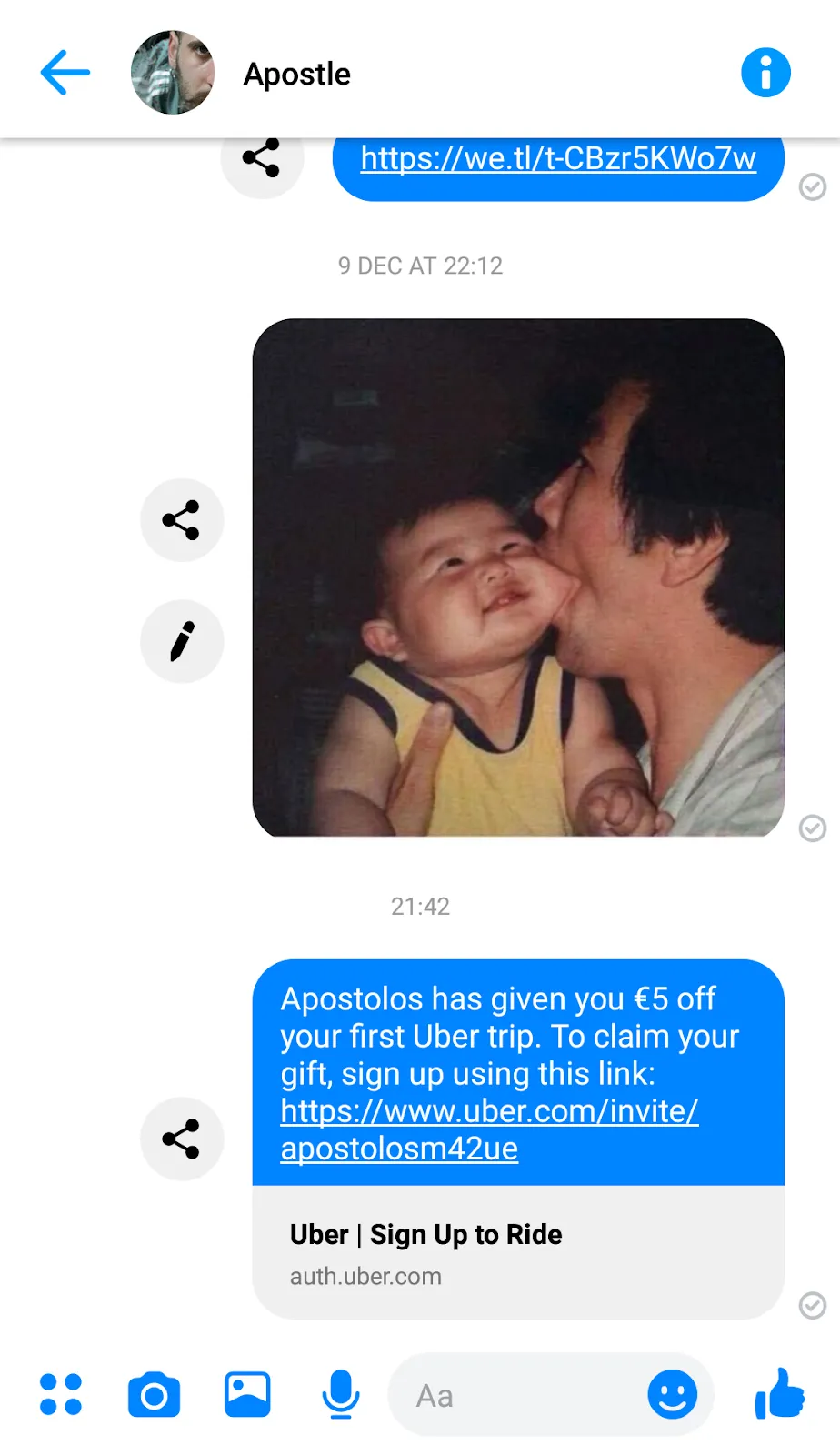
The sum typically covers one free trip, which is how the customer referral program has traditionally been presented for current users.
Since then, the quantity of Uber referral benefits has varied, but Uber has always provided useful and dual-sided Uber points.
Also, signing up and sharing is all that’s required to win the rewards; the referred buddy must then join up, and their first trip is free; it's very simple.
Uber is the definition of a successful referral program for the following reasons:
Easy to use and appealing:
Uber users can access the program by tapping on the "free rides" option in the menu.
Using "free rides" as the CTA (call-to-action), rather than "refer a friend," successfully grabs customers' attention and entices them to tap and discover more.
Mobile-friendly:
Because Uber is an app, its referral program is particularly mobile-friendly.
As a result, it’s simple to send a fast recommendation while on the road.
In addition, each client gets a unique invite code that they can instantly share with their friends, making it easier for Uber to monitor customer referrals and provide prizes and customer support.
Variety of sharing options:
Users can share directly by copying and pasting their unique referral link via email, SMS, and social media platforms.
Social sharing is made simple by the availability of several alternatives which accommodate how consumers interact with their referred friends.
Dual-sided benefits:
When a new referral takes their first Uber trip, the person who referred them immediately receives credit equivalent to a free trip.
In addition, the recommended buddy also receives ride credits throughout their first few trips, encouraging them to become a regular client.
These rewards are definitely the road to happy customers and enhanced retention rates!
Every Morning Brew newsletter has a specific sharing section called "Share the Brew."
It introduces the reader to the promotional strategy; clicking on it will send you to Morning Brew's referral center.
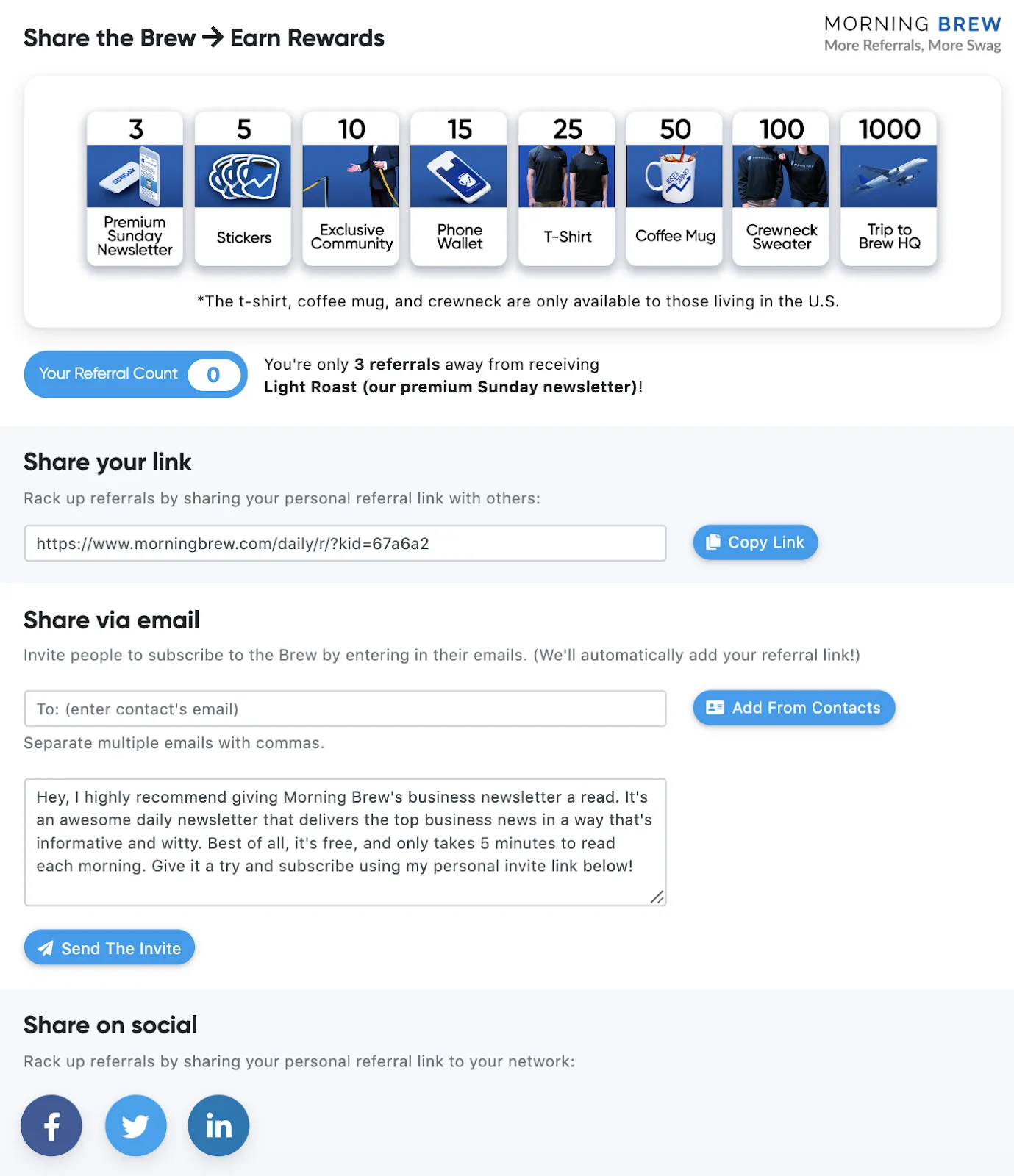
But the company doesn’t prompt you to "Share the Brew" until the conclusion of the newsletter post.
This is a wise choice for two reasons:
Furthermore, the "Share the Brew" part serves as a CTA since it displays the number of referrals required to reach the next milestone or incentive and emphasizes the referral advantages.
Lime Crime is a cruelty-free beauty business known for its vegan cosmetics; the brand is also known for setting trends and being a digital native-focused company.
The company has implemented a smart and simple marketing scheme that has reaped wonderful benefits.
Lime Crime has offered a dual-sided reward program motivating customers to buy right at that moment and encouraging new leads.
When existing customers recommend their friends, the friends get 20% off when they make a purchase and 20% goes to the referrer.
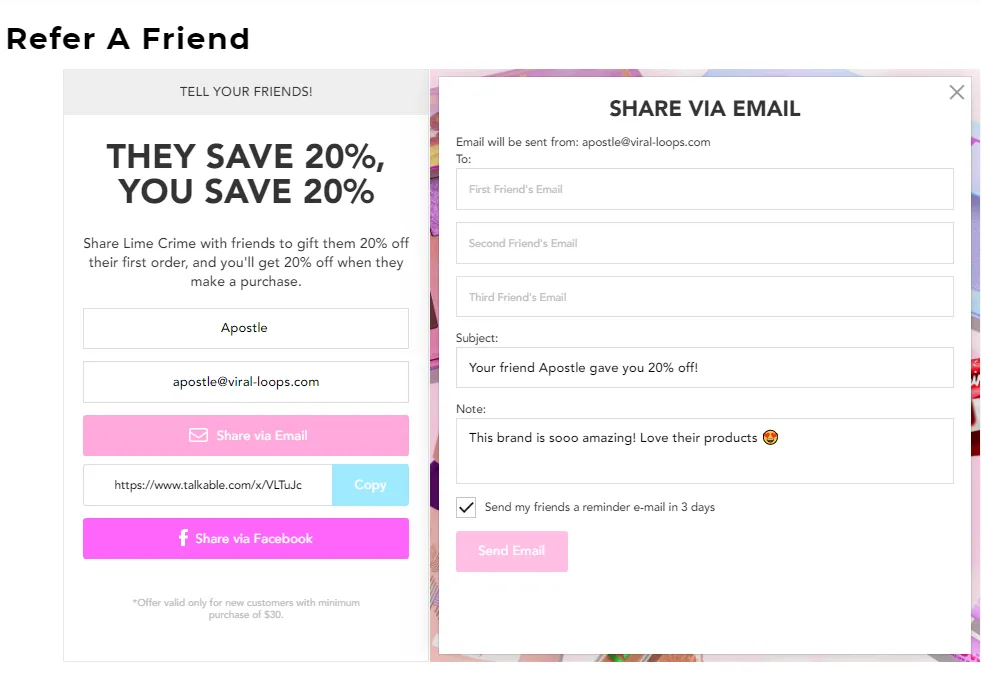
Moreover, the brand’s sign-up form is straightforward; all you have to do is submit your basic information, email, and agree to the terms and conditions.
Lime Crime’s vivid imagery and easy-to-find program have made customers return while also enjoying their reward system, but there’s more!
If you look closely at the above image, the "Share through Facebook" button is highlighted but the "Calls to Action '' for the email and the copy of the special URL have a desaturated shade of color.
This is most likely due to statistics from Lime Crime indicating that posting on Facebook has a higher conversion rate for referrals.
Referral programs can be straightforward, and if you know the fundamentals of how they operate, you can design efficient referral marketing plans tailored to your particular needs.
This will help customers return due to their fantastic experience with your business rather than just with the product.
So let’s ask you something; how do you intend to implement a referral marketing strategy at your company?
We can help you answer this question if you book a demo with us to discuss what suits you best.
Cheers!